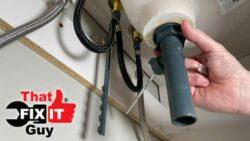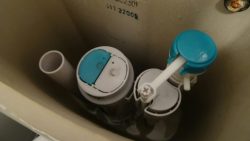In this article, you will discover seven practical and budget-friendly approaches to resolving a leaky toilet in collaboration with a skilled plumber. Not only will you learn essential techniques to tackle the issue effectively, but you will also gain valuable insights into estimating the cost of hiring a plumber for toilet repairs. By understanding these cost-effective methods, you will be equipped with the knowledge needed to fix a leaky toilet while minimizing unnecessary expenses.
Check the flush valve seal
The flush valve seal is an essential component of the toilet that helps prevent water from flowing continuously into the bowl. To ensure the proper functioning of the seal, it is important to inspect it regularly for any signs of damage. Look for cracks, tears, or other visible damage that may indicate the need for replacement.
If the seal is dirty, it may also cause leakage. Use a clean cloth or sponge to carefully clean the seal, removing any dirt or debris that may be preventing a proper seal. Be sure to use gentle cleaning agents that won’t damage the seal.
If the seal is worn or cracked, it is crucial to replace it. You can find replacement seals at your local hardware store or plumbing supply store. Make sure to purchase a seal that is compatible with your toilet model to ensure a proper fit. Follow the manufacturer’s instructions to correctly install the new seal.
Adjust the flapper chain
The flapper chain is responsible for connecting the flapper to the flush lever and allowing it to open and close smoothly. If the chain is too loose, it can prevent the flapper from closing properly, leading to continuous water flow. On the other hand, if the chain is too tight, it may not allow the flapper to open fully, resulting in incomplete flushing.
Inspect the chain and check if it is properly aligned. Adjust the chain length accordingly to ensure that it allows the flapper to open and close without any hindrance. You can usually make adjustments by simply loosening or tightening the chain links.
After making adjustments, test the flush to ensure that the flapper opens and closes smoothly, allowing the proper amount of water to flow into the bowl.
Replace the flapper
If adjusting the flapper chain doesn’t resolve the leakage issue, it may be necessary to replace the flapper itself. Before starting the replacement process, turn off the water supply to the toilet. This can usually be done by turning the shut-off valve located near the base of the toilet.
To remove the old flapper, detach it from the flush valve by unhooking the chain or removing any attached mechanisms. Take note of the flapper’s position and orientation to ensure proper alignment when installing the new one.
Install the new flapper by following the manufacturer’s instructions. Make sure to align it correctly with the flush valve to ensure a proper seal. Once installed, turn on the water supply and carefully check for any leaks. If there are no leaks, the replacement was successful.
Tighten the flush valve
The flush valve is secured to the toilet tank with a mounting nut. Over time, this nut may become loose, leading to water leakage. To fix this, identify the exact location of the mounting nut securing the flush valve. You may need to remove the toilet tank lid to access the nut.
Using pliers or a wrench, tighten the mounting nut carefully. Be sure to avoid over-tightening, as this can cause damage to the flush valve or other components. Tighten the nut until it is securely in place, but not excessively so.
After tightening the flush valve, check for any signs of leakage or drips. If the leakage persists, it may be necessary to inspect and address other potential causes, such as damaged seals or flappers.
Inspect the fill valve
The fill valve is responsible for regulating the water level in the toilet tank. It is important to regularly inspect the fill valve for any visible leaks or cracks that may be contributing to a leaky toilet. Look for any signs of water around the base of the valve or on the surrounding area.
If you notice any leaks or cracks, you should clean or replace the fill valve as necessary. Cleaning the valve involves removing any built-up debris or sediment that may be obstructing its proper functioning. If cleaning doesn’t resolve the issue, it may be necessary to replace the valve entirely.
In addition to checking for leaks and cracks, ensure that the water level adjustment of the fill valve is properly set. A correct water level adjustment helps prevent overflows and ensures the toilet flushes efficiently. Follow the manufacturer’s instructions or refer to the toilet’s user manual for guidance on adjusting the water level.
Adjust the water level
Toilet water level plays a crucial role in the toilet’s overall functionality. If the water level is set too high, it can result in constant water flow into the overflow tube, leading to wastage and potential leakage. On the other hand, if the water level is set too low, it may not provide enough water for effective flushing.
To adjust the water level, locate the water level adjustment screw or float mechanism, which can typically be found inside the toilet tank. Adjust the screw or float to either lower or raise the water level as needed. Test flushes after adjusting the water level to ensure that the toilet is using water efficiently and effectively.
If you are unsure about how to properly adjust the water level, refer to the toilet’s user manual or consult a professional plumber for guidance.
Check the toilet tank bolts
Loose or rusted toilet tank bolts can also contribute to a leaky toilet. Inspect the tank bolts for any signs of looseness or rust. If you notice any bolts that are not securely tightened, use a wrench or pliers to tighten them.
It is important to exercise caution when tightening the bolts to avoid overtightening, which can potentially crack the toilet tank. Tighten the bolts just enough to ensure a secure fit but without applying excessive force.
In the case of rusted tank bolts, it is advisable to replace them with new bolts. Rust can weaken the bolts and may lead to further leakage or damage over time. Replace rusted bolts promptly to maintain the integrity of the toilet tank.
Inspect the supply line
The supply line connects the toilet tank to the water supply in your home. It is important to inspect the supply line regularly for any signs of leaks or damage. Inspect the entire length of the supply line, from the toilet tank to the shut-off valve or wall connection.
If you notice any leaks or damaged areas, tighten any loose connections using pliers or a wrench. Ensure that all connections are securely tightened to prevent any water leakage. If the supply line is old or severely damaged, it is advisable to replace it with a new one. Damaged supply lines can lead to significant water damage if not addressed promptly.
Install a toilet repair kit
If DIY methods and individual component replacements don’t solve the leakage problem, it may be worth considering installing a toilet repair kit. These kits typically contain all the necessary components to address common toilet issues and provide a comprehensive solution.
Purchase a toilet repair kit that suits your toilet model and follow the included instructions for installation. The kit may include components such as a fill valve, flapper, flush valve, and other essential parts. Install the components according to the instructions provided, ensuring proper alignment and fit.
After installation, it is important to test the toilet for leaks. Flush the toilet several times and carefully examine the tank and surrounding area for any signs of leakage. If there are no leaks, the repair kit installation was successful, and you have fixed the leaky toilet.
Call a professional plumber
In some cases, despite your best efforts and DIY attempts, you may not be able to fix the leaky toilet on your own. When faced with persistent leakage or complex issues, it is advisable to call a professional plumber.
Research and contact a reliable plumber who specializes in toilet repairs. Discuss the problem you are facing and provide any necessary details for an accurate assessment. The plumber will likely ask questions about the type of toilet, the symptoms of the leak, and any attempts you have made to address the issue.
Based on the information provided, the plumber will be able to diagnose the problem and provide a cost estimate for the repair. Schedule a convenient appointment for the plumber to visit your home and make the necessary repairs.
Remember that hiring a professional plumber ensures that the leaky toilet is fixed effectively and efficiently, minimizing the risk of further damage and potential water wastage.





